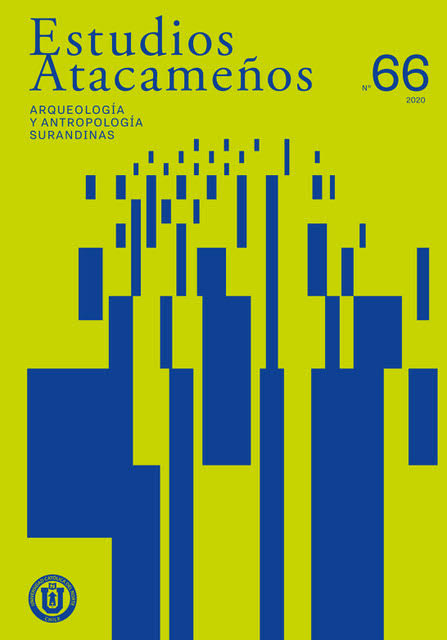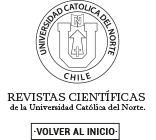“…and we’re all going down!” Underground ontologies in conflict in Tierra Amarilla
DOI:
https://doi.org/10.22199/issn.0718-1043-2020-0055Keywords:
mining, sinkholes, underground ontologies, equivocation, ChileAbstract
On November 2013 a massive sinkhole appeared in a terrain near Tierra Amarilla, a small mining town in northern Chile. This event immediately raised the alarms of the local population, given the possible occurrence of new sinkholes directly in the inhabited area of the city. In order to deal with such fears, the local mining companies established a task force with representatives of the community, authorities and mining experts. At the center of this task force work was the difficult cohabitation between two contrasting ontologies about the local mining underground, one associating it with risks and ruination and the other with transparency and control. Using science and technology studies (STS) conceptual devices, on this paper the work done by this task force is analyzed as a process through which the first ontology was solely seen as an erroneous understanding of the second one, a “myth” emerging out the local population’s ignorance. Such framing end up producing a closure for the controversy that left untouched the neighbor’s original matters of concern, becoming more an example of a radical equivocation than a perfect application of corporate social responsibility, as it was presented afterwards.
Downloads
References
Astudillo, F. (2015). Un río fantasma: Espacio, regionalidad y olvido en el Valle de Copiapó (Tesis para optar al grado de Master en Antropología Social). Facultad Latinoamericana de Ciencias Sociales, Buenos Aires.
Ballard, C., & Banks, G. (2003). RESOURCE WARS: The Anthropology of Mining. Annual Review of Anthropology, 32, 287–313.
Ballestero, A. (2018). The underground as infrastructure? Water, figure/ground reversals and dissolution in Sardinal. En Hetherington, K. (Ed.), Environment, Infrastructure and Life in the Anthropocene. Durham, NC: Duke University Press.
Ballestero, A. (2019). Touching with Light, or, How Texture Recasts the Sensing of Underground Water. Science, Technology, & Human Values, 44(5), 762–785. https://doi.org/10.1177/0162243919858717
Bebbington, A. (2012). Underground political ecologies: The second Annual Lecture of the Cultural and Political Ecology Specialty Group of the Association of American Geographers. Geoforum, 43, 1152–1162.
Bebbington, A., Hinojosa, L., Bebbington, D., Burneo, M., & Warnaars, X. (2008). Contention and Ambiguity: Mining and the Possibilities of Development. Development and Change, 39(6), 887–914. https://doi.org/10.1111/j.1467-7660.2008.00517.x
Blaser, M., & de la Cadena, M. (2017). The Uncommons: An Introduction. Anthropologica, 59(2), 185–193. https://doi.org/10.3138/anth.59.2.t01
Bolay, M. (2014). When miners become “foreigners”: Competing categorizations within gold mining spaces in Guinea. Resources Policy, 40, 117–127. https://doi.org/10.1016/j.resourpol.2014.02.001
Braun, B. (2000). Producing vertical territory: Geology and governmentality in late Victorian Canada. Ecumene, 7(1), 7–46. https://doi.org/10.1177/096746080000700102
Bremner, L. (2013). The Political Life of Rising Acid Mine Water. Urban Forum, 24, 463–483.
Bridge, G. (2013). Territory, now in 3D! Political Geography, 34, 55–57. https://doi.org/10.1016/j.polgeo.2013.01.005
Castro, V., Escobar, M., & Salazar, D. (2012). Una mirada antropológica al devenir minero de Taltal y Paposo. Chungará (Arica), 44(3), 401–417. https://doi.org/10.4067/S0717-73562012000300004
Collins, H., & Evans, R. (2007). Rethinking Expertise. Chicago: The University of Chicago Press.
de la Cadena, M. (2015). Earth Beings: Ecologies of Practice across Andean Worlds. Durham and London: Duke University Press.
De Sousa Santos, B. (2005). The Future of the World Social Forum: The work of translation. Development, 48(2), 15–22. https://doi.org/10.1057/palgrave.development.1100131
Deleuze, G., & Guattari, F. (1988). A Thousand Plateaus. Capitalism and Schizophrenia. London: The Athlone Press.
Diamond Drilling Services. (2016). Programa de Sondajes Mesa Mineraâ”Comunidad de Tierra Amarilla Octubre de 2016. Copiapó, Chile.
Ey, M., & Sherval, M. (2016). Exploring the minescape: Engaging with the complexity of the extractive sector. Area, 48(2), 176–182.
Frodeman, R. (2003). Geo-logic: Breaking ground between philosophy and the earth sciences. Albany, NY: State University of New York Press.
Godoy Orellana, M. (2016). Minería popular y estrategias de supervivencia: Pirquineros y pallacos en el Norte Chico, Chile, 1780-1950. Cuadernos de historia (Santiago), (45), 29–62. https://doi.org/10.4067/S0719-12432016000200002
Goodwin, C. (1994). Professional Vision. American Anthropologist, 96(3), 606–633.
Hauser, A. (1993). Hundimiento Asociado a Laboreos Subterráneas en Mina “Santos”, Tierra Amarilla, III Región. Informe Técnico. Santiago, Chile: SERNAGEOMIN.
Henare, A., Holbraad, M., & Wastell, S. (2007). Introduction: Thinking through things. En Thinking Through Things: Theorising artefacts ethnographically. London: Routledge.
Holbraad, M., Pedersen, M. A., & Viveiros de Castro, E. (2014). The Politics of Ontology: Anthropological Positions. Recuperado 31 de julio de 2019, de https://culanth.org/fieldsights/the-politics-of-ontology-anthropological-positions
Ingeosat. (2014). INFORME TÉCNICO FINAL - ESTUDIOS TOPOGRAFICOS PARA CATASTRO DE MINAS SUBTERRANEAS EN EL DISTRITO MINERO DE TIERRA AMARILLA. Copiapó, Chile: Ingeosat SpA.
Jensen, C. B. (2017). New ontologies? Reflections on some recent ‘turns’ in STS, anthropology and philosophy. Social Anthropology/Anthropologie Sociale, 25(4), 525–545.
Jorquera, P. (2017). ESPACIOS ATRAVESADOS, LUGARES VIVIDOS Y TIEMPOS MATERIALIZADOS: DINÁMICAS LOCALES EN UNA PEQUEÑA CIUDAD MINERA-PIRQUINERA. ILUMINURAS, 18(45), 221–237.
Kinchy, A., Phadke, R., & Smith, J. (2018). Engaging the Underground: An STS Field in Formation. Engaging Science, Technology, and Society, 4(0), 22–42. https://doi.org/10.17351/ests2018.213
Kratzsch, H. (1983). Mining Subsidence Engineering. Berlin, Heidelberg, New York: Springer-Verlag.
Kuhn, T. S. (1991). La estructura de las revoluciones cientificas. Ciudad de Mexico: Fondo de Cultura Economica.
Marschik, R., & Fontboté, L. (2001). The Candelaria-Punta del Cobre Iron Oxide Cu-Au(-Zn-Ag) Deposits, Chile. Economic Geology, 96(8), 1799–1826. https://doi.org/10.2113/gsecongeo.96.8.1799
Mol, A. (1999). Ontological politics: A word and some questions. En Actor Network Theory and After. Oxford: Blackwell.
Mol, A. (2002). The Body Multiple: Ontology in Medical Practice. Durham, NC: Duke University Press.
Mumford, L. (2010). Technics and Civilization. Chicago, IL.: University Of Chicago Press.
Nash, J. (1993). We eat the mines and the mines eat us: Dependency and exploitation in Bolivian tin mines. New York, NY: Columbia University Press.
Nystrom, E. (2014). Seeing Underground: Maps, Models and Mining Engineering in America. Reno: University of Nevada Press.
Ortega Martínez, L. (2010). LA MINERÍA DEL COBRE DEL NORTE CHICO (TRADICIONAL) Y LOS MEDIANOS Y PEQUEÑOS PRODUCTORES EN PERSPECTIVA HISTÓRICA. Si Somos Americanos, Revista de Estudios Transfronterizos, X(2), 37–59.
Pickering, A. (2017). The Ontological Turn: Taking Different Worlds Seriously. Social Analysis, 61(2), 134–150.
Pike, D. (2007). Metropolis on the Styx: The Underworlds of Modern Urban Culture, 1800-2001. Ithaca, NY: Cornell University Press.
Rodríguez, J. C., & Medina, P. (2011). Reconversión, daño y abandono en la ciudad de Lota. Atenea (Concepción), (504), 147–176. https://doi.org/10.4067/S0718-04622011000200009
Salas Carreño, G. (2017). Mining and the living materiality of mountains in Andean societies. Journal of Material Culture, 22(2), 133–150. https://doi.org/10.1177/1359183516679439
Sanchez, L. E. (2016). Ponderación de Factores Antropogénicos y Naturales que causarían La Subsidencia de Terreno en La Comuna de Tierra Amarilla, Región de Atacama, Chile (Memoria para optar al título profesional de Geógrafo). Universidad de Chile, Santiago, Chile.
Scott, J. C. (1998). Seeing Like a State; How Certain Schemes to Improve the Human Condition Have Failed. New Haven and London: Yale University Press.
Sturgis, P., & Allum, N. (2004). Science in Society: Re-Evaluating the Deficit Model of Public Attitudes. Public Understanding of Science, 13(1), 55–74. https://doi.org/10.1177/0963662504042690
Taussig, M. (2010). The Devil and Commodity Fetishism in South America. Chapel Hill & London: The University of North Carolina Press.
Tejada, M. S. (2015). Los sitios de significancia comunitaria y la apropiación del patrimonio, comuna de Inca de Oro, III Región de Atacama, Chile. Universidad de Sevilla. Departamento de Historia, Teoría y Composición Arquitectónicas, Sevilla, España.
UdA. (2016). Mesa Minera de Tierra Amarillaâ”Informe final de los aspectos técnicos del protocolo de acuerdo entre Gobierno Regional de Atacama, comunidad organizada de Tierra Amarilla y Empresas mineras. Copiapó, Chile: Universidad de Atacama.
Viveiros de Castro, E. (2004). Perspectival Anthropology and the Method of Controlled Equivocation. Tipití: Journal of the Society for the Anthropology of Lowland South America, 2(1), 1–20.
Williams, R. (2008). Notes on the Underground; An Essay on Technology, Society and the Imagination. Cambridge, MA.: MIT Press.
Woolgar, S., & Lezaun, J. (2013). The wrong bin bag: A turn to ontology in science and technology studies? Social Studies of Science, 43(3), 321–340. https://doi.org/10.1177/0306312713488820
Wynne, B. (1995). Public Understanding of Science. En S. Jasanoff, G. Markle, J. Petersen, & T. Pinch (Eds.), Handbook of Science and Technology Studies (pp. 361–388). London: Sage.
Zepeda, C. (2016). Proceso histórico: El día que la Mesa Minera confirmó que no existen socavones bajo Tierra Amarilla. Atacama Viva. Recuperado de http://www.atacamaviva.cl/proceso-historico-el-dia-que-la-mesa-minera-confirmo-que-no-existen-socavones-bajo-tierra-amarilla/
Downloads
Published
Issue
Section
License
Copyright (c) 2021 Sebastian Ureta, Andrés Contreras

This work is licensed under a Creative Commons Attribution 4.0 International License.

All works published in Revista Estudios Atacameños (ISSN on line:0718-1043) Revista Estudios Atacameños Creative Commons International 4.0 attribution (CC BY 4.0) licence.
Authors remain the owners of their work and may republish their articles elsewhere without having to request permission, as long as they indicate that the work was originally published in Revista Estudios Atacameños (ISSN on liine:0718-1043).












